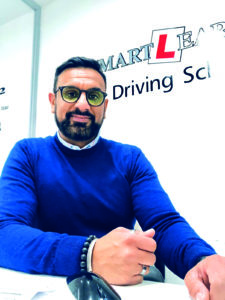Tommy Sandhu
Honest Business
He has a celebrated profile in and around Coventry, his home city, though not just because he’s an ADI driving a Porsche. Born to immigrant parents, and the first British born Asian to join the family, he was soon helping and supporting his father in various businesses, from corner shops and milk rounds, to chip shops and taxis. “After completing my GSCE exams I decided that I no longer wanted to continue education and began my career in the retail world at the then famous Texas Home Care store. I rapidly progressed through the company ranks, obtained an assistant management position, then moved to B&Q where they sponsored me to achieve both an HNC and a Post-Grad certificate in Business Management”. It set him on an entrepreneurial business path, gaining more business and management experience and then setting up his own independent design clothes shop. “After a few years of running and directing the store, I decided it was time for a career change, sold the shop and moved into driving instruction where I soon developed what has become Coventry’s largest driving school.”
I first learnt to drive a milk float… I was very young, carrying out my milk rounds in the early hours of the morning using an electric milk float, with next to no traffic on the roads. The old category ‘L’ allowed you to drive as long as the electric vehicle was below a certain weight and only capable of low speeds. I had no lessons, but when I reached seventeen, I moved straight to my practical driving test which took me two attempts to pass.
The 1988 test was very like today’s… with so many fewer vehicles on the roads, it made some of today’s driving challenges much easier.
The practical driving test procedure is still very similar today in the sense of methodology, however in-car gadgets and technology are completely different. Some of these, such as parking sensors and satellite navigation, have added changes to the test and therefore learner training. But more importantly, the rise in traffic levels has created and raised the intensity of hazards, making the test more difficult and the training more involved. Testing and training needed reforms… the process is up to date and aligned with what younger drivers need to learn and adapted to fit modern society. Whilst there are always ways to improve, the systems and current requirements do enhance good driving behaviours.
I set up the ‘Because Your Life Counts’ charity… in the early days of my driving school, we would visit local schools in Coventry alongside the West Midlands fire service and IAM to present to young pupils about the risks of drink and drug driving, along with general road safety advice. Given the terrible road safety statistics for the 16-18 age group, it is absolutely imperative that we do more to educate the younger generations and try to help reduce fatalities among young drivers. As our school grew, we were able to develop this into a registered charity and purchase our own equipment, which now also includes virtual reality headsets and beer goggles. These support our presentations and provide learners with an ‘NVQ Level One Award in Road Safety’. This gives teens the incentive to really get stuck in and it allows us to give something back to the community we work in. If any other ADIs want to get involved with the charity, please search onlineand get in touch.
Young drivers aren’t unfairly singled out… it’s imperative we continue to raise young driver awareness. They have by far the highest rates of both drink and drug driving crashes, according to official statistics; they seem unaware of the real risks, and are often prepared to take those risks without considering the wider consequences beyond just their lives and injuries.
The test can always be improved… the basic mechanics of driving have not been changed since the early test. My personal belief is that the training process itself is good, but it is all down to how it is delivered. Dedicated trainers will ensure their pupils are fully educated, and while it takes a certain amount of skill and luck to pass the test, we as trainers need to be certain they are prepared to tackle any situation safely.
The Honest Truth Campaign (THT) is great… any additional help we can provide to support young or new drivers to aid their understanding of the seriousness of driving a vehicle can, and will, save lives. THT helps support this in a practical, effective and proven way, while also bringing together local instructors, road safety officers and local authorities to work towards a common goal. If all instructors were to get onboard, I believe the campaign would have an even greater impact and we will see more remarkable results.
ADIs should get involved with THT today… instructors are a key influence on their learners, and their own driver attitude and behaviours are often duplicated by pupils long past the test. THT differs from other schemes because it is specifically targeted in simple and visual forms at the younger audience and also provides incentives to ensure that young learners get involved and take ownership of their learning and driving responsibilities.
Driving instructors need to adapt accordingly… as the world and environment changes, such as electric vehicles, automatic transmissions and older drivers, it is down to the individual to ensure they understand the latest training techniques. Driving is a lifelong skill, and one that you never stop learning. It is important to convey that message to all drivers to ensure they understand how to stay safe going forward.
Modern driving brings modern problems… the use of data via technology supports better understanding and improved training situations. Understanding and discussing the natural and technological evolution on the roads thoroughly with new drivers is key to helping them understand their role and responsibilities.
Driving instructors are the first port… their importance to individuals, society and road safety is often overlooked.
In-car technology vastly improves and supports drivers… however, there is a need to support and educate new buyers how to safely use it, and this should be supported by the manufacturers. Technology alone won’t save us, but it can help us to save ourselves if we know how and when to use it. All part of our evolving description.






